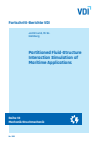Zusammenfassung
In this work, the benefits of employing the partitioned approach in fluid-structure interaction simulations are demonstrated in four different examples: Simulations of a floating offshore wind turbine and a wave energy converter are used to analyze dynamic effects and improve the structural design. A multilayered submersible mixer validates the simulations by assessing local strains, thrust, and torque. Finally, an anisotropic ship propeller made of carbon-reinforced polymer is optimized with an evolutionary algorithm based on coupled simulations concerning efficiency, thrust, and cavitation.
Schlagworte
partitioned coupling Fluid-Structure Interaction Maritime Applications Computational Fluid Dynamics Finite Element Method Finite-Elemente-Methode Fluid-Struktur-Interaktion partitionierte Kopplung numerische Strömungsmechanik maritime Anwendungen schwimmende Windkraftanlage Wellenenergiekonverter Tauchrührwerk Schiffspropeller faserverstärkter Kunststoff floating wind turbine wave energy converter submersible mixer ship propeller fiber-reinforced polymer- Kapitel Ausklappen | EinklappenSeiten
- 21–34 3 Fluid mechanics 21–34
- 81–117 8 Ship propeller 81–117
- 118–123 9 Summary and outlook 118–123
- 124–138 Bibliography 124–138

